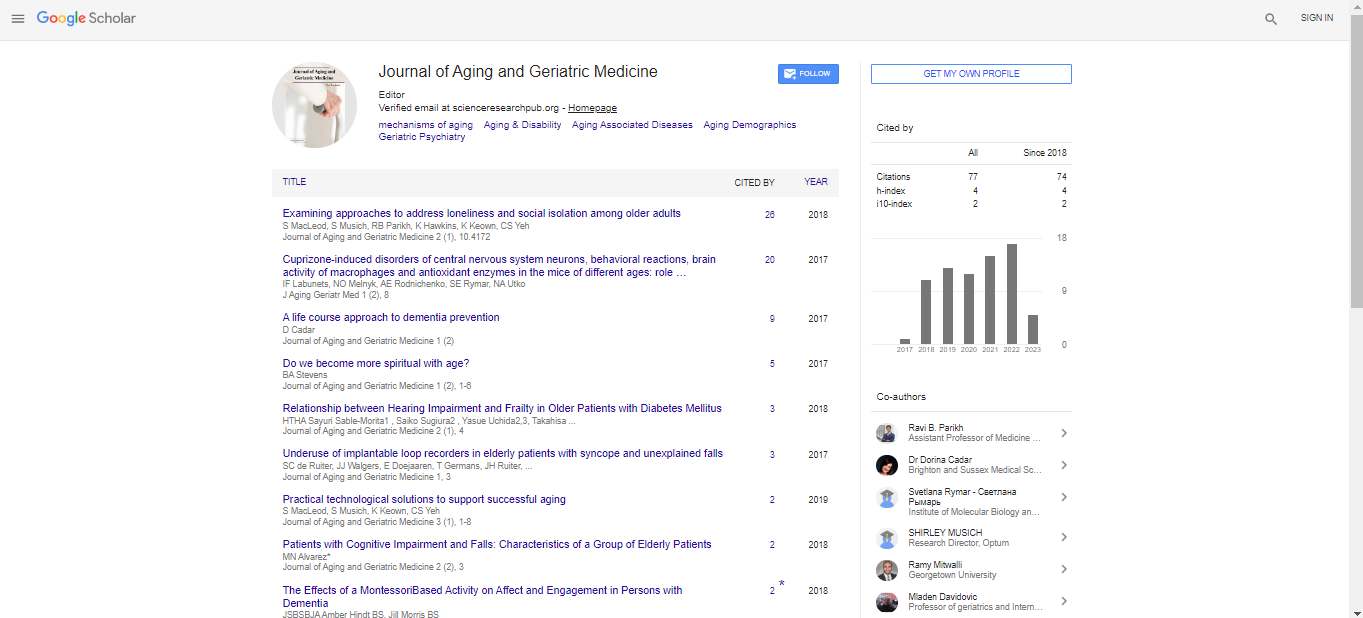Commentary, J Aging Geriatr Med Vol: 6 Issue: 3
Anti-Aging Science: Enhancement of A Discipline
Emmanuelle Tulle*
Department of Biomedical Ethics Unit, McGill University, Montreal, Canada
*Corresponding author: Emmanuelle Tulle, Department of Biomedical Ethics Unit, McGill University, Montreal, Canada
E-mail: emmanuelle@mcgill.ca
Received date: 02 March, 2022, Manuscript No. AGM-22-60760;
Editor assigned date: 04 March, 2022, PreQC No. AGM-22-60760 (PQ);
Reviewed date: 18 March, 2022, QC No AGM-22-60760;
Revised date: 23 March, 2022, Manuscript No. AGM-22-60760 (R);
Published date: 30 March, 2022, DOI: 10.4172/ ISSN: 2576-3946.1000131.
Citation: Tulle E (2022) Anti-Aging Science: Enhancement of A Discipline. J Aging Geriatr Med 6:3.
Keywords: Calorie Restriction
Description
Through archival analysis this composition traces the emergence, conservation, and improvement of biogerontology as a scientific discipline in the United States. At first, biogerontologists' attempts to control mortal aging were regarded as a questionable pursuit due to comprehensions that their sweats were associated with the long history of charlatanic,anti-aging medical practices; the idea thatanti-aging is a “ interdicted wisdom” immorally and scientifically; and the perception that the field was scientifically bereft of rigor and scientific invention. The hard- fought establishment of the National Institute on Aging, scientific advancements in genetics and biotechnology, and harmonious “ boundary work” by scientists, have allowed biogerontology to flourish and gain substantial legality with other scientists and backing agencies, and in the public imagination. In particular, exploration on genetics and aging has enhanced the elevation and pledge of the discipline by setting it on a exploration line in which explanations of the aging process, rather than bare descriptions, have come a central focus. Also, if biogerontologists' sweats to control the processes of mortal aging are successful, this line has profound counteraccusations for how we conceive of aging, and for the future of numerous of our social institutions. Theanti-aging movement is a social movement devoted to barring or reversing aging, or reducing the goods of it. A substantial portion of the attention of the movement is on the possibilities for life extension, but there's also interest in ways similar as ornamental surgery which meliorate the goods of growing rather than detention or master it.
Menopausal Hormone Drugs
There are numerous scientists of this movement with different approaches. Two of the most popular proponents of theanti-aging movement include Ray Kurzweil, who says humanity can master growing through the advance of technology, and Aubrey de Grey, who says that the mortal body is a veritably complicated machine and, therefore, can be repaired indefinitely. Other scientists and significant contributors to the movement include molecular biologists, geneticists, and biomedical gerontologists similar as Gary Ruvkun, Cynthia Kenyon, and ArthurD. Levinson. Still, numbers in the gerontology community in 2003 tried to part their exploration from the perceived pseudoscience of the movement. Anti-aging drug has come a budding and fleetly growing medical specialty as croakers who originally sought treatment for themselves have entered training and instrument in its practice by associations similar as the American Academy ofAnti-Aging Medicine (A4M)co-founded by Dr Robert M. Goldman and Ronald Klatz.
Administration of estrogen and other hormones similar as progestin were vulgarized by the 1966 book Womanlike Ever by Robert A. Wilson. Still, the increase of the use of estrogen was shown to be associated with an increased threat of cancer. Latterly, in 2002, exploration into the long- term goods of estrogen onpost-menopausal women, the Women's Health Initiative, produced substantiation that there were serious side goods. Physicians who define the hormones now define low boluses of the medicines. Research into the long- term goods of hormone relief remedy is continuing, with a 2017 Cochrane methodical review concluding that long- term use may drop the threat of bone fractures or postmenopausal osteoporosis, but increase the threat of stroke, heart attacks, endometrial cancer, and bone cancer. Hormone remedy is generally only recommended for postmenopausal women who are at a high threat of osteoporosis when non-hormonal treatments aren't suitable. Hormone remedy isn't suitable or advised for treating cardiovascular complaint, madness, or for precluding cognitive decline in postmenopausalwomen.The pitfalls of long- term hormonal remedy for women under 50 times of age haven't been determined.
Calorie Restriction
Calorie Restriction (CR) refers to a salutary restriction that focuses on lower calorie input to increase life and reduce age- related complaint in humans. Calorie restriction maintains a low calorie input that helps to regulate the rate of aging and increases the youthful of an individual or beast. Low calorie input has directly been linked to negative energy balance which promotes low body mass index (BMI) and comparatively high tube Dehydroepiandrosterone (DHEA) for bettered life anticipation. Calorie restriction has considerably been rehearsed by pregnant women and people withpre-existing medical conditions analogous as diabetes. The right amount of calorie restriction help pregnant women to achieve positive weight gain whereas a significant drop in calorie input can lead to hypothalamic differences leading to long- term goods in the seed. Moderate CR in diabetic cases increases insulin perceptivity and reduces the amount of hepatic fat in fat existent and type 2 diabetes. Long term CR in aged brutes’results in stem cell function similar to that of the youthful groups. The active stem cell function helps in enhanced recovery of the damaged cadaverous muscle kerchief, which is slower in aged individualities compared to youthful individualities. CR in the United States has shown a prolonged life span in women compared to men as women tend to consume 25 lower calories than men in their continuance. The statistical analysis of CR available foranti-aging movement in humans is not sufficient enough to prove the prolonged continuance associated with CR.
 Spanish
Spanish  Chinese
Chinese  Russian
Russian  German
German  French
French  Japanese
Japanese  Portuguese
Portuguese  Hindi
Hindi 